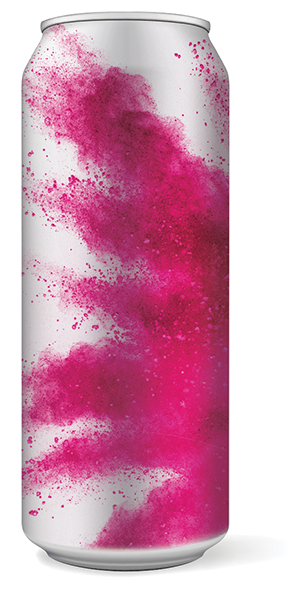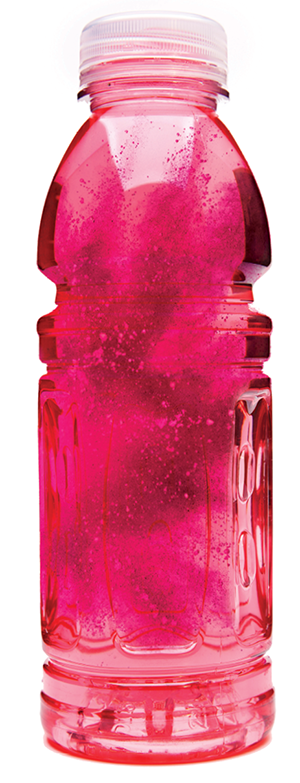 Despite supply challenges over the past year or so, sales of some packaged drinks segments at Iowa’s Kwik Stop chain are surging. “Our sales of energy drinks have increased the last two years,” said Amy Davidshofer, marketing director at the Rainbo Oil-operated convenience retailer.
Despite supply challenges over the past year or so, sales of some packaged drinks segments at Iowa’s Kwik Stop chain are surging. “Our sales of energy drinks have increased the last two years,” said Amy Davidshofer, marketing director at the Rainbo Oil-operated convenience retailer.
“Monster energy drink has been the key driver, but other brands have also shown growth.” New flavors, including limited-time-only expressions, also have been big contributors to the segment’s strong trends, Davidshofer added.
Nationally, 7-Eleven reports growth for energy drinks as well as sports drinks. “Over the past few years, the energy and sports drink industry has grown considerably as demand for functional drinks has increased,” the company said. “At 7-Eleven, we focus our efforts on providing these diverse offerings as energy and sports drinks lead the beverage category and total enterprise in growth.”
Both energy and sports drinks are helping to propel c-store sales of packaged beverages in the aftermath of the COVID-19 pandemic as store traffic improves and as both subcategories benefit from similar trends, namely product innovation and consumer demand for healthier offerings. Retailers and marketers agreed that the prospects for the two segments remain strong, and the drinks are likely to continue to drive c-store shoppers to the cold vault in search of the latest hydration and revitalization solutions.
ENERGIZED DRINKS
Energy drinks continue to be the top packaged beverages subcategory, accounting for 26.8% of total category sales in convenience in 2021, according to the NACS State of the Industry Report of 2021 Data. Average store sales of energy drinks shot up to $9,027 last year from $7,890 in the year prior, while average gross margins improved to 41.85% from 40.63%.
“2021 was an amazing year for energy drinks across outlets as leading brands posted record growth despite several new entrants,” said Leslie Newlee, vice president of insights and category development at Red Bull. The segment also benefited from increased penetration and buy rates, she added, “as occasions were more frequent and the pandemic home-stocking trend continued.”
Product innovation is certainly one of the underlying trends for energy drinks these days—in the form of brands new to the market as well as line extensions. Red Bull’s Summer Edition Strawberry Apricot, for example, “is already outperforming last year’s Dragon Fruit LTO, which became a permanent item this year,” Newlee reported. “And later this year, we’ll launch a new LTO winter edition.”
PepsiCo’s Rockstar Energy brand also has been innovating. Rockstar Unplugged, with hemp seed oils and B vitamins, and Rockstar Punched Aguas Frescas both rolled out recently. “After all the pandemic restrictions, people are looking for rewards and indulgence but within reason,” said Kent Montgomery, head of industry relations at PepsiCo, of the segment’s flavor proliferation. “The products need to taste good as consumers look to treat themselves but also be somewhat healthy.” Indeed, energy drinks that promote health benefits and are comprised of clean and real ingredients are resonating with consumers. “Wellness trends are driving growth for products like MTN DEW Energy, which provides functional benefits with less sugar,” the PepsiCo executive said.
Sports drinks are diversifying as people are getting more mindful and interested in health.
HEALTHY ENERGY ON THE RISE
ZOA energy drink, meanwhile—founded by Dwayne “The Rock” Johnson and distributed by Molson Coors Beverage Co.—launched in March 2021 with a focus on health benefits. Containing turmeric, camu camu and Acerola cherries for vitamin C immunity support, as well as B vitamins to aid mental focus, ZOA’s zero-sugar formula features natural caffeine from green tea extract and green coffee. “Energy is the second-highest functional benefit consumers are looking for in a beverage, behind hydration,” remarked Brenda Jones, vice president, business development and e-commerce at ZOA Energy. Yet, household penetration remains low, she said, as “many consumers desire healthier options to traditional energy drinks.” Response to the new brand has been “nothing short of amazing,” Jones reported, and she expects continued growth. “Today, the healthy energy subcategory accounts for 5% of energy drink sales but is driving 48% of the growth,” she remarked. “We forecast that healthy energy will be 26% of the category by 2024.”
Riot Energy is another emerging better-for-you brand. According to Laura Jakobsen, co-founder and CEO, Riot is seeking to “transform the category, with fresh, clean ingredients.” Noting that the brand contains “real ingredients and offers real functionality,” Jakobsen said Riot is targeted to “next-generation consumers,” ages 19-30, who have a “high awareness in better-for-you energy and its opportunity.”
The Starbucks brand also recently entered the energy drink segment via the North American Coffee Partnership, a joint venture with PepsiCo. Starbucks Baya energy drink launched earlier this year, and according to Montgomery, the product, which gets its caffeine from coffee fruit and beans, is “quickly gaining popularity and becoming a consumer favorite for on-the-go caffeine occasions.”
The blurring of the popular coffee brand and energy drink will likely benefit from strong segment sales during the morning daypart in c-stores. “People want energy these days, especially first thing in the morning,” remarked Wally Albin, manager of Dad’s Quick Mart in Reno, Nevada, which often runs twofer deals on energy drinks. Davidshofer agreed, noting that sales of energy drinks at Kwik Stop spike early in the day. “It’s a bit unexpected, but energy has definitely emerged as a breakfast item,” she said. For that reason, both Newlee and Montgomery encourage c-stores to leverage the opportunity. According to the PespsiCo executive, 40% of MTN Dew Energy is consumed in the morning, and offers like breakfast food/energy drink bundles and value offers help “keep the energy category top of mind.”
It’s a bit unexpected, but energy has definitely emerged as a breakfast item.
NACS category definitions classify liquid energy shots like Vitamin Energy and 5-Hour ENERGY in the health and beauty category, not the packaged beverages category. Living Essentials, owner of the 5-Hour ENERGY brand, introduced a carbonated energy drink into the market last year. The caffeinated and vitamin-infused drinks come in berry, grape and watermelon flavors and contain zero sugar.
“5-hour ENERGY is already a top three energy brand, so the addition of the 16-ounce carbonated beverage product is a natural progression,” CEO and Founder Manoj Bhargava said in announcing the new product in October 2021. “For the times when you’re tired and thirsty, our new carbonated beverage has a refreshing, lighter taste” compared with competitors, Bhargava said.
 RETURN TO SPORTS DRINKS
RETURN TO SPORTS DRINKS
Sports drinks, meanwhile, grew at the fastest rate of all packaged beverage subcategories in 2021, reaching average store sales of $3,205. Like energy drinks, sports beverages are benefiting from innovation, particularly drinks offering electrolytes, reduced calories and clean ingredients, noted Jayme Gough, research manager, NACS. What’s more, with pandemic restrictions lifted, “kids are back to school and sports,” she noted, helping to boost sales of the drinks. Indeed, Scott Wiley, senior manager, brand and category insights, hydration category, at The Coca-Cola Company, said the company’s c-store sports drinks sales last year grew more than 20%, driven by consumer spending increases and purchase frequency.
Brand innovation is also helping to revitalize sales. The latest additions to the BodyArmor line, for example, include Mamba Forever, and for BodyArmor Edge, new additions include Strawberry Slam and Watermelon Wave flavors. 7-Eleven’s private-label Replenish sports drink, meanwhile, expanded last year with Replenish + Caffeine, a caffeinated version designed to help restore electrolytes and energy lost during exercise. “We’re constantly innovating our private brand assortment to meet our customers’ changing needs,” the company said. “The demand for functional beverages, unique energy options and new flavors for Replenish have all been on the rise,” and customers appreciate that the sports drink is a less expensive alternative to other brands.
Segment leaders Gatorade and Powerade are offering more reduced sugar options. Gatorade Fit contains no added sugar, artificial flavors or sweeteners, while Gatorlyte has less sugar than average sports drinks and a specialized electrolyte blend, Montgomery said. Recent introductions from Powerade, meanwhile, include Zero Sugar Watermelon Berry and Zero Sugar Citrus Peach. At Kwik Stop, Davidshofer is considering adding some of the new sports drink options. While the chain was impacted by product shortages last year, she said, “We’re hoping for a bounce back in 2022. Like other categories, sports drinks are diversifying as people are getting more mindful and interested in health.”
Additional coolers at the register really impact impulse buys, especially when people are in a hurry.
KEEPING THE MOMENTUM
Retailers and marketers see plenty of opportunity to keep the momentum behind energy and sports drinks going in 2022 and beyond. Consistent merchandising and marketing support will play key roles, they said. Montgomery pointed to the importance of digital communications that drive consumers to store locations and “layered messaging between the curb and cold vault,” including outdoor signage and gas station TVs. Functional benefit communications, meanwhile, like static clings on cold vault doors help to educate consumers on key ingredients, the PepsiCo executive noted.
Red Bull’s Newlee and Coca-Cola’s Wiley, meanwhile, recommend incremental placement of energy and sports drinks beyond the vault, such as in open-air racks, at the pump and at the checkout counter. That’s a practice Iowa’s Kwik Stop adheres to, according to Davidshofer. “Additional coolers at the register really impact impulse buys, especially when people are in a hurry,” she said. And while energy and sports drinks sales tend to “ebb and flow,” Davidshofer is optimistic about the beverage segments. “There’s room for more growth,” she said, “and we plan to take advantage of it.”